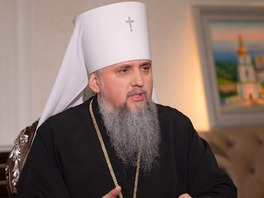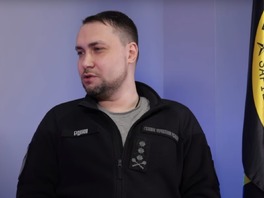All these people came to Ukraine to rob and kill Ukrainians, destroy Ukrainian houses, rape Ukrainian women and steal Ukrainian children. But they are not the ‘second army of the world’ anymore. Moreover, they are not an army at all. It is a crowd of gloomy and very docile men of all ages in similar blue attires. They are Slavs and residents of the ‘national republics’ of Russia: Yakutia, Tuva, the Far East, Sakhalin, St. Petersburg, and Pskov; Orthodox and Muslims; criminals from Russian penal colonies and regular conscripts. All of them are Russian prisoners of war who are in a special camp somewhere in the west of Ukraine. Apostrophe got acquainted with the conditions of their detention.
Preceding the full-scale Russian invasion, this facility served as a center for minor criminal offenders. Yet, as Petro Yatsenko, a spokesperson for the Coordinating Headquarters for Prisoner of War Affairs, noted, with the onset of the large war, Ukrainian detainees were relocated, and the institution was refashioned to accommodate Russian captives. The camp's personnel, hailing from the State Department for the Execution of Punishments, have received specialized legal instruction concerning the adherence to regulations safeguarding the rights of prisoners of war.
Respect for the Geneva Convention is revered in the camp, with boards displaying excerpts from international documents outlining prisoners of war rights. They are in Russian, ensuring clarity for all residents. Petro Yatsenko highlights that certain Wagner PMC members, sourced from Russian correctional facilities and swapped before Prigozhin's uprising described their Ukrainian detention as akin to a ‘tourist trip.’













The exact count of prisoners of war remains undisclosed, characterized simply as "enough," according to Petro Yatsenko. Another comparable facility reportedly exists west of Kyiv. Detainees, arriving in groups of 20 to 50 from various front-line regions, endure varying durations of captivity, with some awaiting exchange for months and others confined for well over a year.
Upon arrival, each newcomer undergoes an initial assessment, primarily focused on determining their physical well-being. Notably, a considerable number of individuals exhibit injuries. . Russians with amputated limbs, on wheelchairs, on crutches, with shrapnel injuries and the consequences of frostbite are hospitalized here.
In the initial inspection, military attire is confiscated from detainees, undergoes cleaning and disinfection, and is then stored in a designated room in labeled bags. Upon release through exchange, individuals will reclaim their belongings. Meanwhile, they are furnished with a standard set including a blue coat, shoes, personal hygiene items, additional clothing, and undergo a mandatory two-week quarantine.
Quarantine, distinct from medical isolation, involves psychologists engaging with detainees to assess expectations and work capabilities. The diverse population includes ‘Wagnerians’ and former inmates from ‘Storm Z,’ some with serious convictions in Russia. Instances of unexpected aggression demand special attention. Attempts by individuals from Russian camps to impose familiar prison rules were promptly quashed by local staff.
Beyond the perimeter, a building displays a map of Ukraine delineating 1991 borders, encompassing Crimea and presently occupied eastern and southern territories—an apt reminder. The adjoining corridor, serving assembly and meal routines for prisoners of war, is adorned with portraits of Ukrainian hetmans on one side and recent political figures like Stepan Bandera, Roman Shukhevych, and Yevhen Konovalets on the other.
Russian propaganda brewed such a cool porridge in the brains of certain individuals captured by Ukraine that, upon seeing a portrait of Stepan Bandera, they insisted it portrayed a young Vladimir Putin.



Prisoners of war adhere to a strict daily routine at the camp, rising at 6 a.m. and retiring at 10 p.m. While uninterrupted sleep is the norm, air alarms, triggered by potential night Russian missile attacks or MiG-31 flights, can disrupt this schedule. In such cases, detainees are swiftly evacuated to bomb shelters as per security protocols. Although our visit was unaffected by alarms, camp officers described how columns of prisoners descend to storage during these incidents, with wounded individuals on crutches, wheelchairs, or stretcherscarried by their comrades. Some Russians interpret these air alarms specifically, with remarks like, ‘I wish at least they hit us once.’
Weekday and weekend routines diverge for prisoners of war; on weekdays, labor is mandatory (our visit occurred on Thursday). Regardless of the day, detainees receive personal time, access to religious services, library visits, TV programs, and the chance to communicate with relatives.
Relatives exhibit a notable lack of interest in their soldiers engaged efforts to ‘denazificate’ Ukraine. Throughout the camp's two-year existence, hardly any Russian family members have visited their husbands and sons, despite available programs. While exceptions exist, the general sentiment is one of indifference, often expressed as, "We see that you are in good conditions." However, some provide monetary assistance, channeling funds to designated accounts for their loved ones. Russian detainees also earn a modest salary, around 10 hryvnias daily, from camp labor, which is deposited into these accounts. This income facilitates purchases at an onsite store, offering items like coffee, tea, water, cigarettes, sweets, stationery, socks, underwear, wristwatches, and even various types of sausage.


Up to 10,000 hryvnias are spent every month on the maintenance of each of the prisoners of war. They come from the state budget. However, as discerned, only a fraction of these funds trickles down to Russians, and even that portion must be earned. The majority of the funds are allocated to associated expenses essential for their upkeep.
In the common area, a sizable wall-mounted television caught my eye, accompanied by a stack of New Testaments and a book on the afterlife. Adjacent, a well-stocked kitchen includes a refrigerator filled with assorted food, and a game room features tables with chess and backgammon sets. The masterfully crafted backgammon boards, likely handmade, exhibit skilled artistry, with a lion intricately engraved on the box.






Detainees rest in an adjoining room resembling a well-ordered military barracks. Impeccably arranged beds, each labeled with an occupant's name. There is a bedside table next to each bed with books on some of them.
Prisoners of war exhibit diverse literary preferences. The library offers "Petro the First," the Bible, Daria Dontsova's detective ‘A Frog with a Wallet,’ (the author is popular in Russia, but known for her extremely low-quality graphomaniac style of writing) and works on electrical engineering for the intellectually inclined. These resources are available at the library, curated by a fellow detainee chosen through discussions with psychologists during quarantine. The library offers an extensive collection, including fiction, algebra textbooks, and Ukrainian history volumes. However, detective tales, sports literature, religious texts, and the Bible are notably favored.












In the hospital, staff permits the journalist to communicate with the Russian patients under treatment. Notably, they provide dental services and medical equipment beyond typical central district hospital standards.However,obsessive questioningof prisoners of war is strictly prohibited. Permission must be sought for any conversation, and if a prisoner declined, one must respect for their decision is paramount. Recording permission, if granted, is strongly encouraged.

However, the majority are open to communication. Take Dmitry, a 30-year-old newcomer from Pskov, without a military background initially. After a month of training, mainly digging dugouts, he was thrust into battle and subsequently captured on January 21 somewhere in the Luhansk region.
He reveals his motive: to earn money, lured by promises of 190,000 rubles monthly ($2,100 ap.). However, he never received them. Engaged in the assault on the positions of the Armed Forces of Ukraine, he was struck by cluster munitions. This incident marked the sole ‘salary’ of the Russian occupier – his first and last – in the form of shrapnel wounds and frostbitten limbs.
Outside, there are wounded individuals, likely permitted to move due to health reasons. Numerous bear physical impairments, with several relying on Ilizarov devices for their injured limbs. Some occupy benches, while others stand against walls, leaning on crutches or seated in wheelchairs. Upon spotting journalists, they fell into a somber silence.




Meet 28-year-old Oleksandr from Sakhalin, confined to crutches. Captured on September 23 last year, approximately six months into his service under a 195,000 rubles per month contract. Before mobilization he worked as a loader.
‘Felt quite well. Never planned to join the army,’ shares Oleksandr willingly. ‘But no one asked me. Received a draft notice, and off I went.’

Despite Putin's public assurances, mobilization in places such as Sakhalin continued into 2023, although it was supposed to end on November 4, 2022. Moreover, the former loader had minimal involvement in combat and special training; right after the Military Commissariat, he was handed a rifle and sent directly to the front, where he was eventually captured near Avdiivka.
In Ukraine, there's a prevalent belief that in Russia, army conscription mainly targets individuals from economically disadvantaged regions like Pskov or Sakhalin, leaving metropolitan areas like Moscow or St. Petersburg untouched.
The experience of 25-year-old Aleksandr from St. Petersburg challenges this stereotype. Drafted on October 6, 2022, during an "official" partial mobilization, he endured a month of training, followed by deployments near Kreminna and the more challenging Bakhmut direction. After a year of service, he found safer living conditions in a Ukrainian prisoner of war camp.

Conversations with certain prisoners of war can be mentally taxing. Take Kirill, a 20-year-old recruit from ‘Storm Z’ unit, transferred from a Far East correctional colony. Previously serving time for a double murder and robbery, he joined enticed by Russian Ministry of Defense recruiters, promising full rehabilitation for six months of service, along with monthly payments ranging from 105,000 to 220,000 rubles. Kirill found himself surrounded during a counterattack against the Armed Forces of Ukraine in the Vuhledaru area, leading to his capture.

According to Kirill, the discipline in ‘Storm Z’ unit doesn't differ from that in ‘regular’ Russian units. Their combat leader had a history of serving time as a convict.
The man believes that the Russian army attacked Ukraine to defend their own country. However, he struggles to provide a substantive explanation for this perspective.
Prisoners are assigned to production roles based on the outcomes of psychological assessments.






Specialists delve into the origin of everyone's skills. In this instance, a workshop crafting wicker furniture, including tables and chairs, operates with manual labor. These items are tailored to the specifications of paying companies. Hence, if you purchase a wicker chair in Ukraine, it could very well have been crafted by a Russian soldier in captivity.
In the workshop, we encounter a Ukrainian, 44-year-old Yevhen from the Luhansk region. He became a captive due to the Ukrainian Armed Forces' counteroffensive in the Kharkiv region and has been here since the fall of 2022. His wife remains at home.





Enlisted in the ‘people's militia corps,’ he has been detained for a year and a half, likely staying until the war's end; Russians are not keen on exchanging such captives. In contrast, Kirill from ‘Storm Z’ has better prospects for repatriation.
Notably, some individuals mobilized from the temporarily occupied territories of Donetsk and Luhansk regions display limited lessons learned. One Donetsk resident, left without ammunition, surrendered, claiming he defended his land.
Lunchtime arrives. The column of prisoners neatly forms in the same corridor, heads cautiously bowed under the stern gaze of Stepan Bandera, whether from a portrait or the heavens. With hands folded behind their backs and a slight hunch, they shuffle into the dining area to wash their hands and have their meals.










Prisoners of war prepare their meals by themselves, future coockes undergo psychological selection. They operate their own bakery. On the day of our visit, lunch includes borsch, millet porridge with a meat cutlet, and salad. Fish and potatoes are on the menu for dinner. I sampled the food; portions are substantial. While not as in a Kyiv restaurant, and the borsch could use a bit more salt, but it is noteworthy that every other person here (those not injured or under treatment) is overweight.
The conditions under which Ukrainian soldiers return from Russian torture camps and the grim fate of many of our prisoners raise questions about the fairness of Ukrainian treatment towards captives. However, war comes with customs and rules. If we stop treating Russian prisoners like this, we risk losing our moral high ground. Our focus should be on bringing our captured compatriots home, showcasing Ukraine as a humane European nation deserving assistance. In the face of adversity, it is essential for good to triumph over evil.






